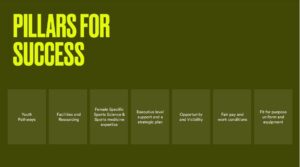Keywords: female athlete, conference, sports medicine

Three years and four virtual summits after the last Isokinetic Football Medicine conference in London (2019), participants convened in person for this year’s conference focusing on The Player’s Voice. Held over 3 days, it featured numerous talks and debates among sport scientists, coaches, physiotherapists, doctors, and athletes.
As a female healthcare practitioner attending with two other female colleagues, it was no surprise to see the discrepancy in the male:female ratio of speakers and attendees. After all, football and medicine [1] are areas traditionally dominated by our male counterparts. However, the women’s game is growing, and we were delighted to attend an open debate session titled “The Rising Tide: Women’s Football”.
This session was hosted by Dr Clare Ardern, Editor in Chief of the Journal of Orthopaedic & Sports Physical Therapy (JOSPT). The panel comprised Kate Mahony (Sydney Swans Executive General Manager), Dr Charlotte Cowie (current Football Association Head of Medicine), Karen Kotila (physiotherapist and board member of the Danish Society of Sports Physiotherapy), and Rebecca Smith (ex-New Zealand football captain).
7 pillars for success

Despite strides made in the growth of women’s football over the past years, inequalities between men’s and women’s football remain [2]. Kate Mahony set out 7 pillars for success in the women’s game. Here I highlight those that are worth thinking about in our approach to Sport and Exercise Medicine (SEM) in women’s sports:
- Youth pathways
- We need more youth pathways for girls, especially at an age range when sports participation tends to decline [3]. As the introduction of title IX was a springboard for an explosion in female participation in sport in the US [4], grassroots input will lead to a natural progression in the game.
- Existing and future youth pathways need to cater to the female athlete. Girls and boys have fundamentally different physiological makeups, e.g., peak height velocity ages, hormonal changes, and injury risk profiles.
- Facilities and resourcing
- This also needs to be specific to the female athlete’s needs. For example, in a women’s team of mainly semi-professional athletes, a better alternative to having a full-time physiotherapist may be a part-time therapist with evening availability.
- Sport science/medicine expertise
- Medical and backroom staff should understand the female athlete and the problems that are specific to, or that disproportionately affect, them (e.g., relative energy deficiency in sport, menstrual cycle dysfunction, pregnancy, urinary incontinence).
- One potential high-impact, easy-to-implement intervention is addition of questions about female athlete health in the hiring process for backroom staff.
- Staff should ideally be aware of the existing gender data gap [5] and should advocate for increased knowledge on the female athlete.
What now?
The audience then engaged the panel in discussion about how to progress the women’s game. Below are some take-home messages:
- Consider how we can play a role in this, starting with small things we can do to influence organisations we are involved with (Kate Mahony)
- Inclusion starts with ourselves and how we create that space in our unique spheres (Charlotte Cowie)
- Football is a sport for all, “it is not about creating watertight shutters between genders”, we are not working to take anything away from the game but to add to it (Karen Kotila)
- Women’s football offers unique opportunities as well as a lot more positivity, “if you’re not in it already come join us cos it’s a hell lot of fun!” (Rebecca Smith)
Quoting Dr Celeste Geertsema from a different session on shared decision making in sport, “We come to these conferences not for information, but for transformation”. In the UK, the huge success of the recent Women’s Euros 2022 has propelled the sport into the media and public spotlight. As practitioners working in sport, how can we contribute to furthering the growth of women’s football and sport in general? We would be keen to hear your thoughts on how to continue this conversation.
Clare Arden (@clare_ardern)
Charlotte Cowie (@Drccowie)
Kate Mahony (@Kate_Mahony_)
Karen Kotila (@KarenKotila)
Rebecca Smith (@bexsmithkiwi)
Author
Bethany Koh (@bethanykoh) is a current GP trainee, UCL SEM student, and recreational footballer based in London.
References
- Sardar, M., Badri, M., Prince, C., Seltzer, J. and Kowey, P., 2014. Underrepresentation of Women, Elderly Patients, and Racial Minorities in the Randomized Trials Used for Cardiovascular Guidelines. JAMA Internal Medicine, 174(11), p.1868.
- Wrack S. Women’s football has seen a decade of progress but there is much more to do. Guardian [Internet]. 2020 [cited 20 June 2022];. Available from: https://www.theguardian.com/football/blog/2020/jan/02/womens-football-decade-of-progress-2020
- Eime, R., Harvey, J. and Charity, M., 2019. Sport drop-out during adolescence: is it real, or an artefact of sampling behaviour?. International Journal of Sport Policy and Politics, 11(4), pp.715-726.
- Kaestner R, Xu X. Title IX, Girls’ Sports Participation, and Adult Female Physical Activity and Weight. Evaluation Review. 2010;34(1):52-78.
- Criado-Perez, C., 2019. Invisible women. London: Penguin Random House.